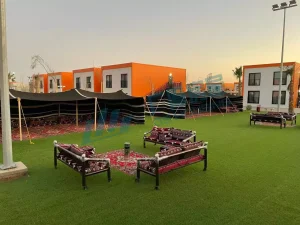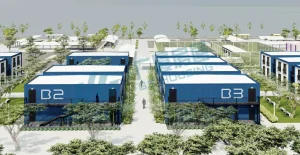Can Manufactured Container Homes Alleviate the Homeless Crisis?
Can Manufactured Container Homes Alleviate the Homeless Crisis?
Container homes that are produced offer a way to address the issue of homelessness by delivering quick setup times and eco-friendly living spaces at an affordable cost. The use of these container homes has proven effective in lowering numbers. However, challenges, like government regulations and how the public perceives them, must be tackled to maximize the positive effects of these homes.
A Social Problem: the Homelessness Crisis
The problem of homelessness is a social concern impacting millions of people around the world. It signifies more than a lack of housing; it also reflects a larger failure to uphold fundamental human rights and dignity. The issue is complex and involves multiple factors that contribute to its severity.
Factors Contributing to Homelessness
Several elements contribute to the homelessness crisis, including economic instability, lack of affordable housing, mental health issues, and systemic inequalities. These factors create a complex web that makes it challenging for individuals to secure stable housing.
Current Solutions and Their Limitations
Typical approaches such as shelters and temporary accommodations frequently do not fully tackle the underlying reasons for homelessness, offering fixes without ensuring lasting security or respect for those impacted.
The Concept of Manufactured Container Homes
Container houses produced in times have arisen as a viable option for tackling the issue of homelessness that has been on the rise lately.
What Are Manufactured Container Homes?
Container houses that are manufactured are built from shipping containers in a process that involves modular and industrialized techniques to guarantee top-notch construction quality. They are made structures that offer flexibility and energy efficiency while being eco-friendly, reflecting the ethos of sustainable construction practices known as “green building”.
Benefits of Using Container Homes for Housing
There are advantages to using prefabricated container homes including easy setup and minimal environmental impact thanks to their uncomplicated and safe design with low foundation needs. They have a lifespan of over 20 years and can be repurposed multiple times making them a sustainable solution for tackling homelessness.
GS HOUSING‘s Role in Providing Solutions
At the cutting edge of housing solutions, GS HOUSING leads the way, with top-notch prefabricated housing systems designed to cater to a wide range of needs.
Overview of GS HOUSING Products
GS HOUSING offers a variety of products showcasing integrated construction methods with their flat-packed container homes designed for quick assembly without any wastage or loss during the process of putting them together and taking them apart at the site in line with the country’s focus and principles of sustainable prefabricated building design.
To learn more about what they offer, you can check out the range of products from GS HOUSING.
How GS HOUSING Products Meet the Needs of the Homeless Population
GS HOUSING’s offerings are ideal for tackling homelessness because they are cost-effective and easily scalable. The efficient and well-managed manufacturing process enables cost management while ensuring high production efficiency. This guarantees that large projects can be completed quickly to offer aid to those requiring assistance.
Their fresh strategy is comparable to “Constructing Homes Similar to Producing Automobiles,” merging planning with construction processes while focusing on quality assurance and packaging within a system of operations. This method not only cuts expenses but also boosts the effectiveness and pace of delivering homes.
Utilizing these methods allows GS HOUSING to provide a realistic route to easing homelessness with respectful and enduring housing options.
Potential Impact on the Homeless Crisis
Case Studies of Successful Implementations
Studying how designed prefabricated container homes have been put into use offers valuable lessons on how they can help address the issue of homelessness effectively. This creative solution has been warmly received by urban areas and groups for its ability to offer quick and dignified housing solutions.
A practical example is when certain initiatives used these houses to establish a sense of community for people facing issues. These projects not only offered shelter but also nurtured a feeling of togetherness and community among the residents. Similar endeavors in cities, like Los Angeles and Amsterdam, demonstrated that prefabricated container homes could be quickly set up to address housing requirements while upholding standards of excellence and eco-friendliness.
These real-world examples demonstrate how manufactured container homes can be customized to suit settings and inhabitants, thanks to their flexible and adaptable nature.
Long-term Benefits for Communities and Individuals
The advantages of choosing container homes go beyond just providing immediate housing assistance; they also offer long- term benefits for communities by providing a sustainable solution that aligns with environmental objectives. Their prefabrication process, flexibility, energy-saving design, and environmental protection features make them a popular choice for local authorities looking for eco-construction options.
Living in a container home offers individuals stability and a sense of dignity that traditional shelters may not provide. These homes give a feeling of lasting permanence that allows residents to move forward with their lives assuredly. The reusability of these structures adds value as a solution, in the long run, by cutting down on frequent new constructions and reducing waste.
Furthermore, the affordability of residences promotes a more effective distribution of resources, enabling governments and organizations to assist a greater number of individuals without sacrificing quality or safety standards.
Challenges and Considerations for Implementation
Regulatory and Zoning Issues
While there are plenty of benefits to using container homes, they do come with their fair share of obstacles to overcome. Dealing with regulations and zoning restrictions can be a roadblock that needs careful navigation for these homes to become more widely accepted.
Sometimes local regulations may not fully align with the architectural aspects of container homes and may need modifications or special considerations to be taken into account to comply with the rules in place successfully. Finding a way through these requirements involves a joint effort among decision-makers, builders, and members of the community so that these creative housing solutions can seamlessly blend into the current system.
Moreover, zoning regulations could limit the placement of these homes in locations that can hinder their availability in areas with the greatest need. Addressing these obstacles necessitates collaborating with local officials to push for modifications that promote the integration of prefab container homes into broader housing plans.
Addressing Public Perception and Stigma
Addressing opinions and social views towards alternative housing options such as prefab container dwellings is a key factor to think about too. Folks’ approval greatly impacts the outcomes of housing projects focusing on those in need.
Communities should be informed about the advantages and possibilities of these homes as options to traditional housing choices, with successful examples showcasing how these buildings have positively improved people’s lives.
Collaborating with leaders and engaging residents in the planning phase can help garner acceptance by ensuring projects resonate, with community values and requirements. Improving the perception of dignity and sustainability offered by homes can help rally backing for efforts to address homelessness in creative ways.
To learn more about how GS HOUSING’s offerings support these objectives in mind with this vision, explore the range of products offered by GS HOUSING.





